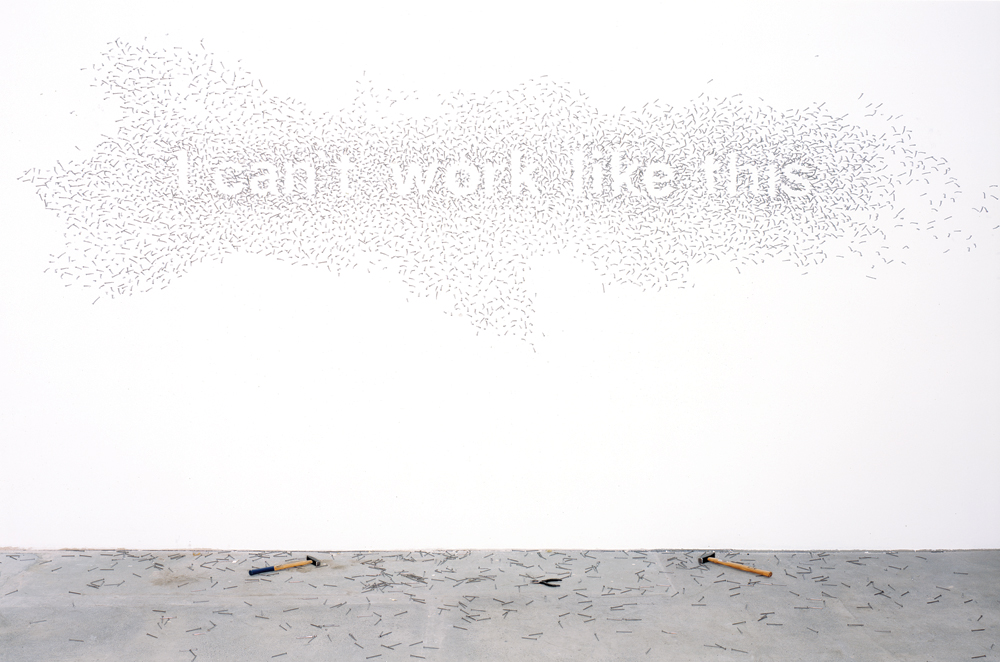« Reviews
9 ARTISTS
Walker Art Center - Minneapolis
Curated by Bartholomew Ryan
A Provocative Proposal
By Christina Schmid
I can’t work this way. The letters emerge from a cluster of nails hammered into the white gallery wall. Natascha Sadr Haghighian’s memorable albeit reluctant contribution to a 2007 art fair proved immensely attractive: part of the Guggenheim’s collection, it now graces a wall of the Walker Art Center’s most recent exhibition, “9 Artists.” Its deep ambivalence-a gesture of frustration and resistance refigured into a valuable art-fair commodity, an utterly collectible critique-is symptomatic of the eight artists’ work curator Bartholomew Ryan selected for the show.
The artists share an attitude of knowing complicity, a wariness of art’s much-lauded criticality. Rooted in the ripple effects of late 20th century identity politics, their diverse practices probe modes of belonging at the intersections of obstinate individualism and visions of community unhinged from essentialism. In the resulting work, art’s criticality is not so much portrayed as exhausted but effectively masked: moments of silliness, even buffoonery, and a taste for paradox reveal glimpses of profundity, as if inadvertently. In Hito Steyerl’s How Not To Be Seen. A Fucking Didactic Educational .Mov File (2013) a deadly politic of digital visibility looms amid the hilarity of dancing pixels hopping off into low resolution: military drones’ cameras can translate one square foot of land into one pixel.

Natascha Sadr Haghighian, I can’t work like this, 2007, wall installation, nails, two hammers. Courtesy the artist and Johann König Gallery, Berlin.
Far from mere parody, provocative proposals abound in “9 Artists.” At times, their ostensible absurdity is cloaked in sincerity. Renzo Martens literally puts economist Richard Florida’s theory of art as a tool for capital accumulation to the test at the artist’s Institute for Human Activities, located in the Republic of Congo. Yael Bartana’s utopian trilogy And Europe Will Be Stunned (2007-2011) presents the fictional fate of the Jewish Renaissance Movement (JRMiP), a real group the artist founded in Poland. In his interview with theorist Leo Bersani, a longtime skeptic of same-sex marriage as the road to conformity, Bjarne Melgaard escalates the range of political gestures on view by espousing a deadpan brand of militant gay separatism. Nastio Mosquito performs a related kind of unruliness in the guise of various alter egos, while Liam Gillick’s vaguely ominous language pieces slyly reflect the corruptive, corrosive mechanisms of political and institutional dogma.
As a whole, “9 Artists” comes across as a little bit jaded, deliberately provocative, and reluctant to indulge definitive statements on contemporary art-”because nobody makes those claims anymore,” curator Ryan writes in the catalog. But the artists’ irreverent adversity cannot conceal a desire for criticality, regardless of how compromised. More challenging still is another longing that barely dares speak its name: is there an alternative to wary complicity and knowing compromise? Ryan recognizes this stealthy desire in Martens’ and Bartana’s work, but it is most tangible in Danh Vo’s I M U U R 2. Steeped in affect, the objects from the collection of Martin Wong not only embody a piece of family history but a sense of curiosity and kinship that far exceeds conventional notions of belonging. Vo’s work is a gentle provocation, unafraid of sentiment.
(October 24, 2013 - February 16, 2014)
Christina Schmid is a writer, teacher, editor, and critic, who lives and works in the Twin Cities. She is a regular contributor to Flash Art, and Afterimage.
Filed Under: Reviews



































Leave a Reply
You must be logged in to post a comment.